To adapt your crockpot recipes for outdoor cooking, you'll need to make key adjustments for success. Position your cooker in a stable, well-ventilated area and use dark-colored cookware with tight-fitting lids for better heat retention. Add 15-20% more cooking time in cold weather and increase liquid content to prevent food from drying out. Pre-cut ingredients and store them separately at safe temperatures before cooking. Create windbreaks when needed and adjust your cooker's position every 30-45 minutes to track the sun. Monitor internal temperatures rather than relying on standard cooking times. These fundamental changes will improve your outdoor cooking game, but there's much more to mastering the technique.
Temperature Control For Solar Cooking
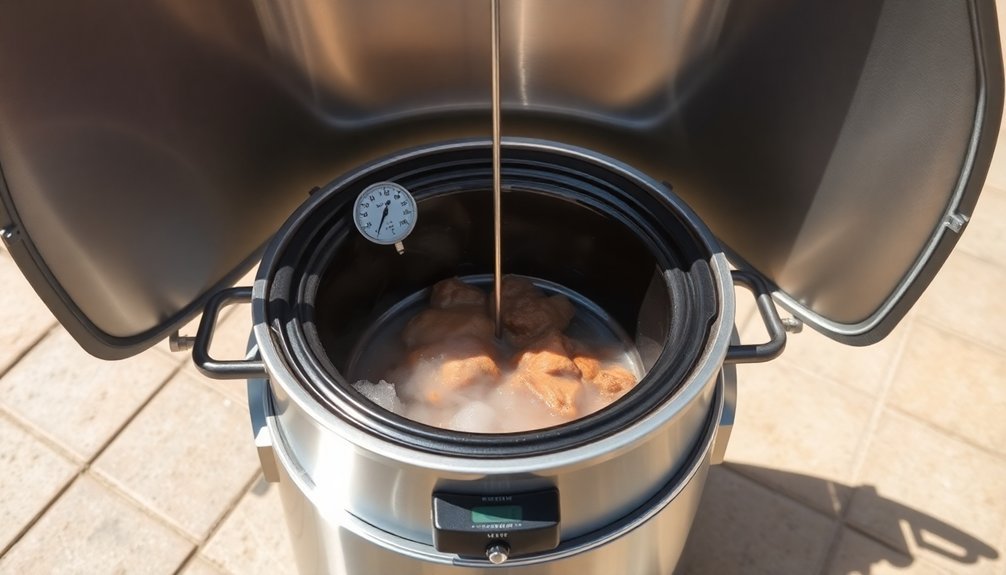
While solar cooking requires patience and attention to detail, maintaining proper temperature control is crucial for successful outdoor meal preparation.
You'll need to position your solar oven directly facing the sun and adjust it every 30-45 minutes for maximum heat collection. Use a reliable thermometer to monitor temperatures between 150-225°F, the ideal range for most recipes.
To maintain consistent heat, confirm your cookware is dark-colored with a tight-fitting lid. Using Type-K thermocouples ensures the most precise temperature readings during cooking.
Add multiple layers of insulation around the cooking cavity using materials like crumpled newspaper or dry leaves. You can boost temperature control by installing reflective panels and adjusting their angles based on the sun's position.
Remember to preheat your solar cooker for at least 30 minutes before adding food, and choose a sheltered spot to protect against wind interference.
Adjusting Cooking Times Outdoors
Because outdoor cooking temperatures can fluctuate greatly, you'll need to adjust your crockpot cooking times accordingly. Monitor your heat source carefully and maintain consistent temperatures by managing your coals and wood supply. You'll want to check your food more frequently than you would indoors, as outdoor conditions can affect cooking times by 10-20%. Setting a timer after calculations will help ensure proper cooking duration.
| Cooking Factor | Adjustment Needed |
|---|---|
| Cold Weather | Add 15-20% time |
| Windy Days | Check coals often |
| Multiple Items | Space items apart |
Remember to preheat your crockpot before adding ingredients, and don't overcrowd it – leave enough space for proper heat circulation. If you're cooking meat, position it in the center of the pot where heat distribution is most consistent. Keep your lid closed as much as possible to maintain steady temperatures.
Managing Moisture While Solar Cooking

You'll need to control steam build-up in your solar cooker by periodically venting the lid or using small gaps to release excess moisture.
For effective evaporation prevention, consider pre-heating your solar oven and using dark cookware to help absorb both heat and moisture efficiently.
When cooking particularly moist foods, you can prop the lid slightly open with a small stick while still maintaining adequate cooking temperatures. Use metal binder clips to secure any loose-fitting lids when needed.
Steam Control Methods
Since effective moisture management can make or break your solar cooking success, understanding steam control methods is essential.
You'll need to balance heat retention with proper ventilation to achieve the best results. Place a tea towel under your pot's lid to absorb excess moisture, or create a small gap between the cooker's glass door and gasket for steam release.
To optimize airflow, elevate your pot using a stand or stones. When condensation builds up, you can quickly open and close the cover to release steam without losing too much heat.
Choose dark, shallow metal pots that don't trap moisture, and consider using phase change materials to regulate heat flow.
Remember that different foods release varying amounts of moisture, so you'll need to adjust your steam control strategy accordingly.
Evaporation Prevention Solutions
While managing moisture is essential for successful solar cooking, several effective solutions can prevent excess evaporation and condensation buildup.
You'll need to balance moisture control with heat retention to achieve the best cooking results.
To minimize condensation on your solar oven's glass lid, try these proven techniques:
- Place a tea towel or cloth napkin under the pot lid to absorb excess moisture.
- Create small ventilation gaps by slightly loosening one latch or using a wooden skewer.
- Reduce liquid content in recipes that tend to produce more steam.
- Position your solar oven to maximize sunlight exposure while maintaining proper ventilation.
Remember that different foods produce varying amounts of moisture, so you'll need to adjust your approach based on what you're cooking.
Regular cleaning of your oven's interior will also help prevent moisture-related issues.
Ingredient Preparation For Outdoor Heat
When preparing ingredients for outdoor crockpot cooking, proper organization and temperature control become essential for both safety and convenience.
You'll want to measure and pack ingredients in labeled zip-top bags before leaving home, and store spices in separate containers for easy access.
Pre-cut your vegetables and store them in sealed containers in a well-insulated cooler kept at 35°F to 40°F.
For meats, brown them beforehand to enhance flavor, and pack them separately from vegetables to prevent cross-contamination.
You can also prepare complete meals like stews and chili in advance, then freeze them to help maintain cooler temperature.
Layer your ingredients strategically by placing vegetables under meat, and add tender herbs near the end of cooking to preserve their freshness.
Don't forget to reduce liquid amounts by 1/3 to 1/2 when adapting recipes.
Equipment And Container Selection
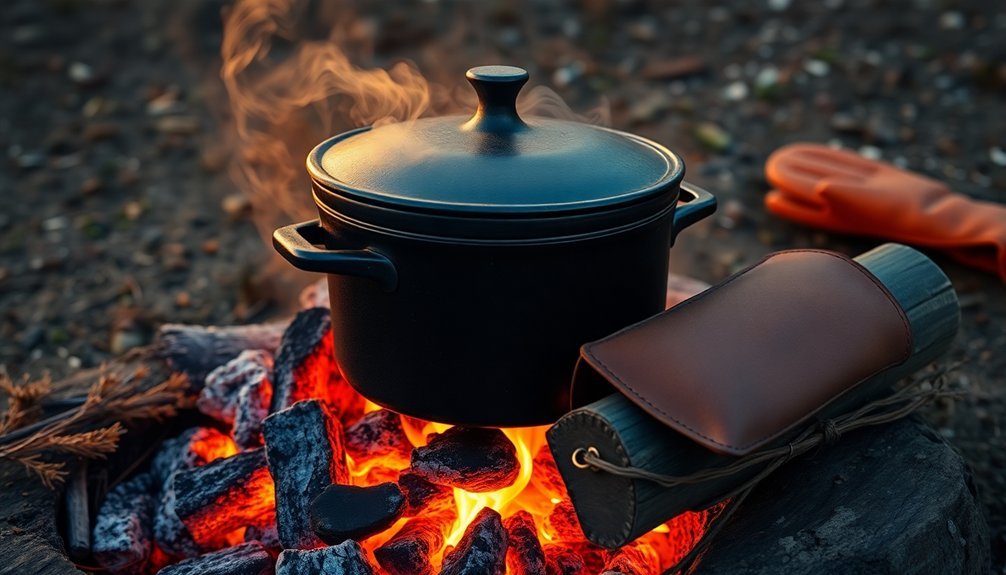
Selecting the right crockpot for outdoor cooking requires careful consideration of both functionality and durability.
You'll want a model that's both portable and stable, with cool-touch housing and secure handles for safe transport.
Key features to prioritize for outdoor cooking success:
- Choose a 6-7 quart capacity with a cooler-style design for easy transport
- Look for models with automatic keep-warm settings and digital controls
- Select units with removable, dishwasher-safe inserts for easy cleanup
- Opt for wide-profile designs with sturdy handles to prevent tip-overs
Your crockpot should have a see-through glass lid to monitor cooking progress without heat loss.
Consider models with built-in cord storage and a hinged, removable cover for added convenience.
PFAS-free materials guarantee safety while maintaining durability for outdoor adventures.
Weather Impact Considerations
When cooking outdoors with your crockpot, you'll need to shield it from rain and humidity that can affect cooking times and food safety.
High humidity levels can extend cooking durations and cause condensation inside your crockpot's lid, while direct rainfall can create dangerous conditions with electrical components.
You'll also want to monitor temperature fluctuations closely, as extreme heat or cold can impact your crockpot's ability to maintain consistent cooking temperatures.
Rain and Humidity Control
Although outdoor cooking with a crockpot can be enjoyable, rain and humidity present unique challenges that require careful planning.
You'll need to protect your cooking setup from the elements while ensuring proper ventilation for safety.
Set up a well-ventilated tarp or use a trekking umbrella to shield your cooking area from rain. Remember that humidity levels greatly affect cooking times – high humidity leads to faster cooking, while low humidity requires longer times.
For successful outdoor crockpot cooking in wet conditions:
- Position your shelter to allow proper drainage and airflow
- Monitor cooking times more frequently due to humidity effects
- Keep cooking supplies organized and easily accessible
- Pack alternative no-cook meals as backup options
Avoid cooking in enclosed spaces like tent vestibules unless absolutely necessary, and always maintain proper ventilation to prevent carbon monoxide buildup.
Temperature Fluctuations Outside
Outdoor temperature fluctuations can dramatically affect your crockpot's performance and cooking times. When it's cold, you'll need to plan for longer cooking durations and higher energy consumption to maintain steady temperatures.
Consider using an insulation blanket if temperatures drop below freezing.
In hot weather, you'll want to position your cooking setup away from direct sunlight, as this can cause temperatures to spike above your target. If you're cooking at temperatures below 225°F on hot days over 85°F, start your cook during evening hours or in a shaded area.
For windy conditions, create a windbreak or position your setup against a wall, especially if you're using auxiliary heating methods.
At high altitudes, focus on cooking to temperature rather than time, as the thinner air will affect your cooking duration.
Solar Position And Heat Efficiency
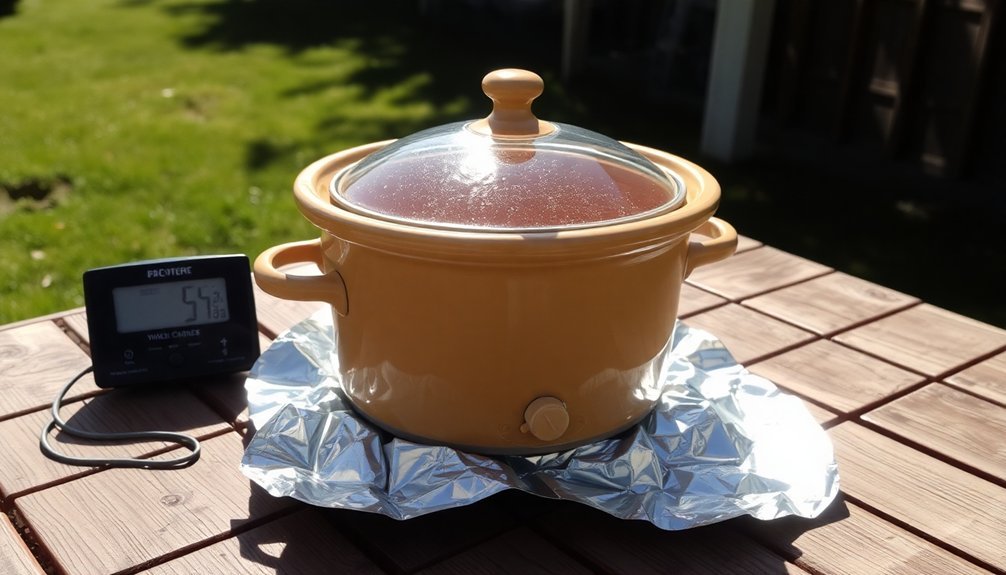
Successful solar cooking depends heavily on proper positioning and heat management techniques.
You'll need to find a spot that gets unobstructed sunlight throughout your cooking time and adjust your cooker's position to track the sun's movement.
Using dark, lidded pots and preheating your solar cooker for 15-30 minutes will maximize heat efficiency.
For ideal results when adapting your crockpot recipes for solar cooking:
- Select a cooker type that matches your needs – box cookers for steady heat, parabolic for high temperatures
- Position reflective panels to concentrate sunlight directly onto your cooking vessel
- Monitor internal temperature with a thermometer to maintain consistent heat
- Keep the lid closed as much as possible to prevent heat loss
Frequently Asked Questions
Can I Use My Crockpot Recipes With a Dutch Oven Over Campfire?
Yes, you can adapt your crockpot recipes for a Dutch oven campfire cooking. You'll need to reduce cooking time by 50-75%, add extra liquid, and adjust ingredient amounts to fit your Dutch oven's capacity.
How Do I Prevent Insects From Gathering Around My Outdoor Cooking Setup?
Keep your cooking area clean, use citronella candles, and hang bug-repelling herbs nearby. You'll also want to seal food containers tightly, remove trash promptly, and run fans to keep flying insects away.
What Alternative Power Sources Work for Crockpot Recipes Outdoors?
You can power your outdoor crockpot cooking using solar ovens for daylight hours, propane stoves for reliable heat, or efficient rocket stoves that burn wood. Each option offers unique benefits for your outdoor cooking needs.
Should I Adjust Spice Levels When Adapting Crockpot Recipes for Outdoor Cooking?
Yes, you'll need to increase spice amounts when cooking outdoors since flavors can dissipate more quickly. Add an extra 25% of dried spices and herbs to maintain the same flavor intensity you'd get indoors.
How Can I Maintain Food Safety When Slow Cooking Outdoors?
Keep your slow cooker at a stable temperature, monitor it closely, and use a food thermometer. You'll need to store perishables in a cooler until use and refrigerate leftovers within two hours.
In Summary
Take your favorite crockpot recipes outdoors by following these solar cooking adaptations. You'll need to monitor temperatures closely, adjust cooking times based on sunlight intensity, and manage moisture levels carefully. Choose the right equipment, prepare ingredients properly, and consider weather conditions before starting. Remember to track the sun's position throughout the day for ideal heat efficiency. With practice, you'll master converting indoor recipes to solar success.

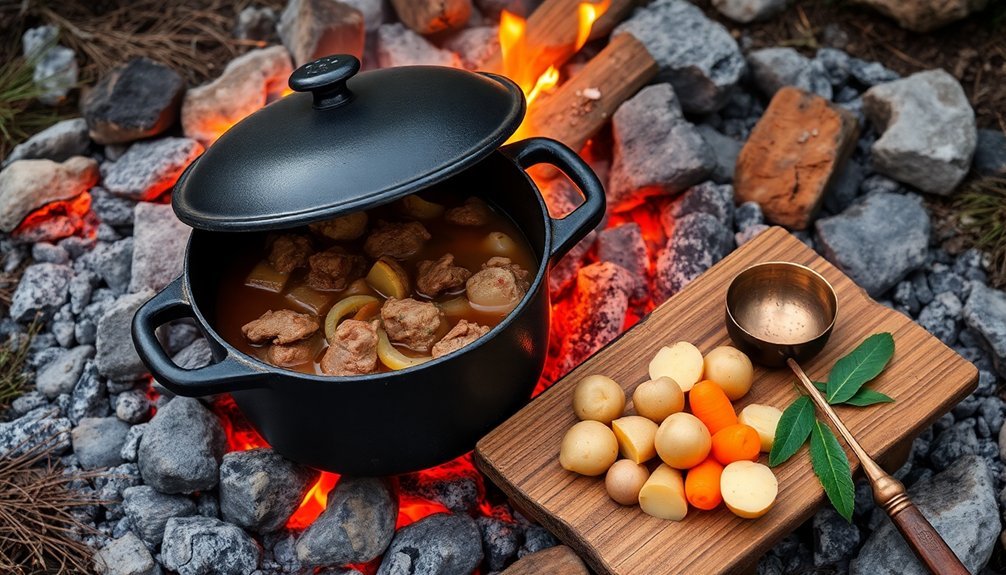
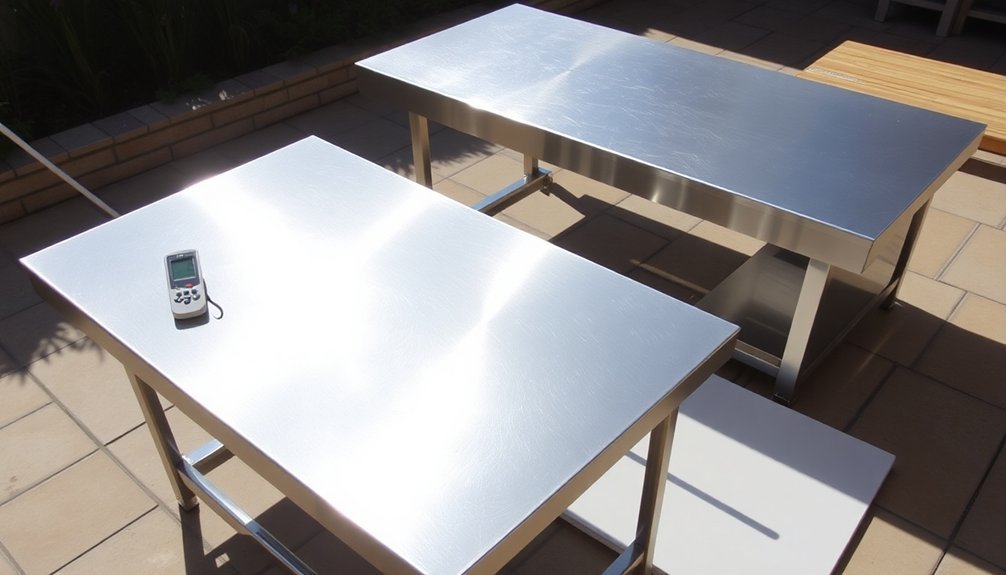
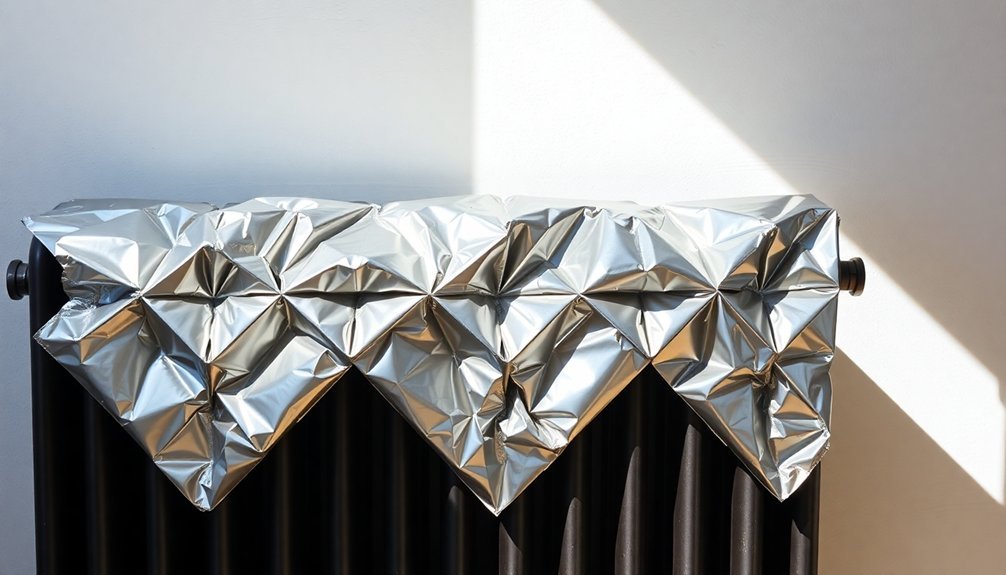

Leave a Reply